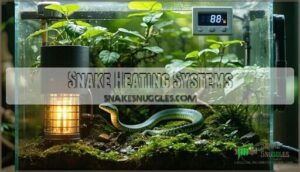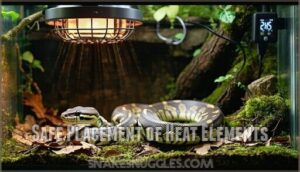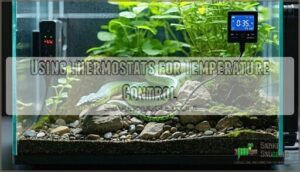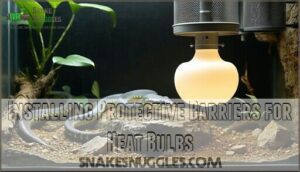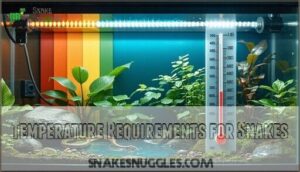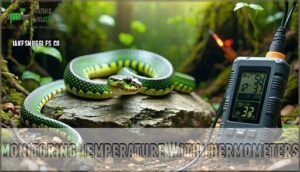This site is supported by our readers. We may earn a commission, at no cost to you, if you purchase through links.
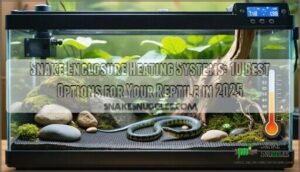 A good snake enclosure heating system keeps your snake healthy by controlling its environment.
A good snake enclosure heating system keeps your snake healthy by controlling its environment.
Snakes rely on external heat to regulate their body temperature, so you’ll need tools like heat mats, ceramic heat emitters, or heating pads.
Place heating elements on one side of the tank to create a warm side and a cooler side, giving your snake options.
Use a thermostat to keep temperatures steady and avoid overheating, and always monitor with a thermometer for safety.
Proper heat gradients mimic nature and help with digestion, movement, and overall health.
Want to know which system fits your setup best? Let’s explore!
Table Of Contents
- Key Takeaways
- Snake Heating Systems
- Top 10 Snake Enclosure Heaters
- 1. Reptile Breeding Rack System with Boxes
- 2. Reptile Heat Mat Thermostat Controller
- 3. Reptile Feeding Box Habitat Cage Kit
- 4. Adjustable Reptile Heating Pad 6×8
- 5. Reptile Heat Pad Under Tank
- 6. Reptile Heat Mat Temperature Control
- 7. Reptile Heat Pad Thermometer Kit
- 8. Reptile Heat Mat Under Tank
- 9. Reptile Heating Mat Temperature Control
- 10. OmniTank Smart Reptile Terrarium Habitat
- Heating System Considerations
- Creating Thermal Gradients
- Advanced Heating Options
- Frequently Asked Questions (FAQs)
- What is the best heating system for a snake enclosure?
- How do I heat my snake enclosure?
- How to keep a snake enclosure warm in winter?
- How to keep a snake warm without electricity?
- How do I keep snakes out of my enclosure?
- How do I choose a heat source for a reptile enclosure?
- What is a heat mat in a reptile enclosure?
- Can ceramic heat emitters heat a reptile enclosure?
- How to properly heat a snake enclosure?
- How to keep a snake tank warm at night?
- Conclusion
Key Takeaways
- You’ll need to create a temperature gradient in your snake’s enclosure with a warm side (85-95°F) and a cool side (65-75°F) so your pet can regulate its body temperature naturally.
- Always use a thermostat with any heating element to prevent dangerous overheating that could harm or kill your snake within minutes.
- Choose your heating system based on your snake’s specific needs, enclosure size, and ambient room temperature—options include under tank heaters for belly heat, ceramic heat emitters for 24-hour heating without light, or smart systems for automated control.
- Monitor temperatures regularly with reliable thermometers placed at both the warm and cool ends of your enclosure to ensure you’re maintaining the proper thermal environment for digestion and overall health.
Snake Heating Systems
Your snake needs proper heating to survive and thrive because reptiles can’t regulate their own body temperature.
You’ll need to select a reliable heating system that creates the correct temperature gradient in your enclosure for your snake’s specific needs.
Importance of Heating for Reptiles
Every reptile in your care depends on proper heating for survival. Unlike mammals, snakes are ectotherms that rely on external heat sources to regulate body functions.
Proper heating is the lifeline for snakes, ensuring they digest food, stay healthy, and thrive in their environment.
- Proper temperature gradients allow snakes to move between warm and cool areas
- Adequate heating is essential for digestion health and immune function
- Winter survival requires artificial heating when temperatures drop
- Without correct reptile heating, snakes will stop eating and eventually die
To maintain snake wellbeing, temperature gradient setup is essential.
Types of Reptile Heating Systems
Reptile heating systems come in two main types: overhead heating and under tank heaters (UTH).
Overhead options include heat lamps for snakes and ceramic heat emitters that provide heat without light.
UTH systems like heat mats offer gentle belly warmth, and radiant heat panels work well for larger enclosures.
You’ll need to match your system to your snake’s specific needs for proper temperature regulation.
Basking Temperatures and Heat Gradients
Now that you know about heating system types, let’s look at how they create proper environments for your snake.
Your reptile’s basking temperatures depend on its species:
- Ball pythons need 88-92°F basking spots
- Corn snakes thrive at 85-90°F
- Boa constrictors require 90-95°F areas
- Kingsnakes prefer 85-88°F zones
The heat gradient lets your snake move between warm and cool areas, just like they’d in nature.
Wattage and ambient room temperature both affect how well your system works.
Top 10 Snake Enclosure Heaters
You’ll find the perfect heating solution for your snake from these top-rated systems that maintain ideal temperatures for health and digestion.
These reliable options include everything from basic heat mats to advanced smart terrariums that take the guesswork out of reptile care, providing a comprehensive approach to maintaining the ideal environment.
1. Reptile Breeding Rack System with Boxes
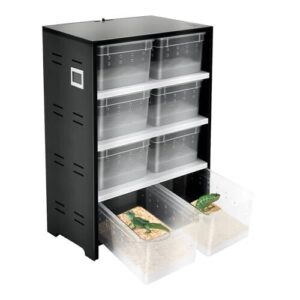
The 25W Reptile Breeding Rack System gives you complete temperature control for your snake collection.
This compact unit features eight clear, pullable boxes with ample ventilation holes. At just 10.6×8 inches, it won’t take up much floor space.
You can customize each box with branches and hides, creating perfect environments for your pets. The included thermostat guarantees ideal temperatures, while the thermometer helps you monitor conditions.
It’s easy to clean and access your snakes without disturbing them. Perfect for small reptiles, but be aware it’s too small for larger species.
Best For: Small reptile or insect keepers needing a compact, customizable habitat with temperature control.
Pros:
- Compact size saves floor space.
- Includes thermostat and thermometer for temperature management.
- Pullable boxes provide easy access and minimal disturbance.
Cons:
- Not suitable for larger reptile species.
- Limited to indoor use only.
- Heating capacity may be insufficient for high temperature needs.
2. Reptile Heat Mat Thermostat Controller
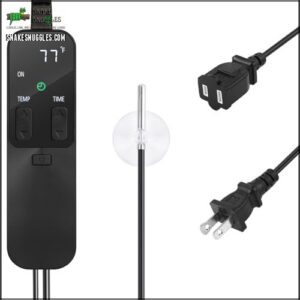
A good thermostat controller is the heart of any effective reptile heating system.
Your heat mat thermostat controller maintains temperatures between 40°F and 108°F with impressive 1°F accuracy. The digital display shows real-time readings while simple UP and DOWN buttons make adjustments easy.
It works with heat pads, ceramic emitters, and heat tape to prevent dangerous overheating. The built-in timer offers 2, 4, 8, or 12-hour settings, and it remembers your settings during power outages.
Most units earn 4.5/5 stars from users who praise their reliability and stability for reptile safety.
Best For: Beginners and experienced reptile keepers who need reliable and stable temperature control for their pet’s habitat.
Pros:
- Maintains temperatures with 1°F accuracy for reptile safety.
- Compatible with various heating elements like pads and emitters.
- Retains settings during power outages for convenience.
Cons:
- Timer functionality may sometimes require manual adjustments.
- Buzzing noise reported in standby/off mode by some users.
- Limited temperature range of 40°F to 108°F may not suit all species.
3. Reptile Feeding Box Habitat Cage Kit
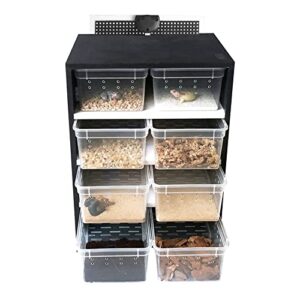
This compact reptile feeding box habitat cage kit offers versatile housing for snakes, lizards, and small amphibians.
Made from high-quality acrylic materials, the kit features 360-degree transparency for easy observation of your pet’s behavior.
At $28, it includes a 13W heating pad, temperature and humidity meter, and eight transparent breeding boxes.
It measures 10.59 x 8.07 x 14.29 inches for the cabinet with smaller inner boxes.
You’ll find this kit perfect for transporting, breeding, or feeding your reptiles.
The durable design is easy to clean but may be outgrown quickly by growing reptiles, making it a good choice for small amphibians.
Best For: Beginners or reptile owners with small amphibians, hatchlings, or invertebrates looking for a compact and affordable housing solution.
Pros:
- Includes a 13W heating pad and environmental monitoring tools.
- Compact, durable, and easy to clean.
- 360-degree transparency for observing pet behavior.
Cons:
- Outgrown quickly by growing reptiles.
- Sliding out bins can be tricky due to design.
- Not suitable for larger or adult pets.
4. Adjustable Reptile Heating Pad 6×8
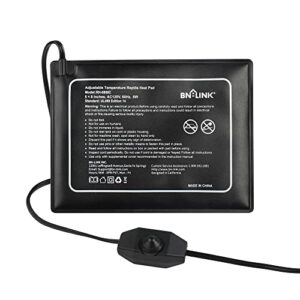
When searching for the perfect heating solution, the Adjustable Reptile Heating Pad 6×8 stands out as an excellent choice.
This compact pad uses just 8 watts of power but delivers steady heat between 104°F and 122°F.
You’ll love the easy setup with its adhesive backing that sticks firmly to glass terrariums.
The waterproof design means you can clean it without worry.
It heats up fast and works well for 10-20 gallon tanks.
With a 15-month warranty from BN-LINK, you get peace of mind too.
Best For: Reptile or amphibian owners with 10-20 gallon glass terrariums who need a compact, energy-efficient heating solution.
Pros:
- Adjustable temperature settings for optimal heat control.
- Easy setup with strong adhesive backing for glass surfaces.
- Waterproof and durable design simplifies cleaning and maintenance.
Cons:
- Limited to use with glass terrariums only.
- May not provide enough heat for larger tanks above 20 gallons.
- Standard design lacks smart or automated control options.
5. Reptile Heat Pad Under Tank
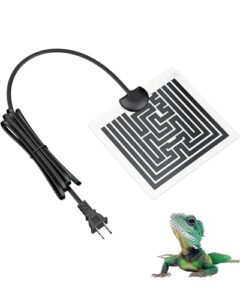
Reliability matters when choosing heating for your reptile.
The Reptile Heat Pad Under Tank provides essential "belly heat" that helps with digestion.
This pad sticks easily to glass terrariums and comes in four sizes to fit various tanks.
Place the included bumpers in the corners to prevent heat buildup.
For best results, use sand or similar substrates that conduct heat well.
You’ll need to add a thermostat for safety, as these pads can overheat.
Remember, these shouldn’t be your only heat source in rooms cooler than 75°F.
They are meant to provide belly heat and should be used in conjunction with other heat sources for optimal results, ensuring the overall reliability of the heating system.
Best For: Reptile owners needing reliable under-tank heating for digestion support in glass or plastic terrariums.
Pros:
- Provides essential belly heat for effective digestion.
- Easy to install with included bumpers for safety.
- Compatible with thermostats for precise temperature control.
Cons:
- Requires additional heat sources in cooler environments under 75°F.
- Can overheat without a thermostat.
- Not sufficient as a sole heat source for larger reptiles.
6. Reptile Heat Mat Temperature Control
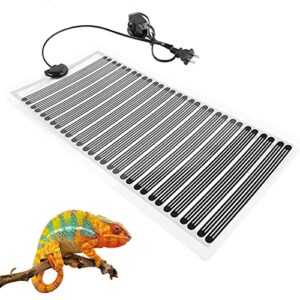
The Reptile Heat Mat Temperature Control system offers precision that your cold-blooded friend will appreciate.
It provides a temperature range from 68°F to 122°F, giving you complete control over your snake’s environment.
Available in two sizes—6×8 inch (11W) for smaller tanks and 8×12 inch (23W) for larger setups—this mat uses carbon film heating material for even warming.
Its built-in smart chip prevents dangerous temperature spikes.
Remember, always pair with a thermostat for safety, as overheating can harm your reptile.
The PVC packaging guarantees durability and proper insulation.
Best For: Reptile owners seeking precise temperature control for small to medium enclosures.
Pros:
- Wide temperature range from 68°F to 122°F.
- Durable and insulated with high-toughness PVC.
- Built-in smart chip prevents overheating.
Cons:
- Requires a thermostat for safe use.
- Limited sizes only for smaller tanks.
- No digital temperature display on the controller.
7. Reptile Heat Pad Thermometer Kit
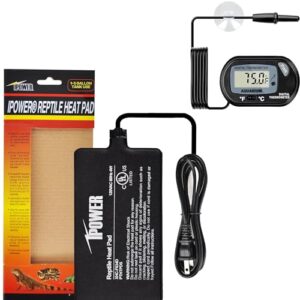
The Reptile Heat Pad Thermometer Kit combines two essential tools for proper snake care.
You get a 4" x 7" heating mat with advanced PTC heating material that transfers heat quickly.
It comes with an LCD digital thermometer to monitor temperatures accurately.
The kit reaches up to 104°F and includes safety features like a control smart chip.
It’s waterproof and uses 3M adhesive for secure attachment.
Remember to use the included rubber feet to elevate your terrarium and prevent fire risks.
This 4-watt system works well for various reptiles and maintains temps between 40-108°F, providing a suitable environment with advanced PTC and a digital thermometer.
Best For: Reptile owners needing an efficient heating solution with accurate temperature monitoring for small to medium terrariums.
Pros:
- Rapid heating with advanced PTC material.
- Waterproof design with secure 3M adhesive backing.
- Includes a digital thermometer for accurate monitoring.
Cons:
- Adhesive may lose effectiveness over time.
- Potential for thermometer quality inconsistencies.
- Requires elevation to prevent overheating risks.
8. Reptile Heat Mat Under Tank
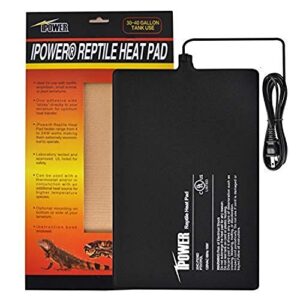
After testing dozens of reptile products, this 8" x 12" heat mat stands out for snake enclosures.
It uses just 16 watts while providing steady belly heat that helps with digestion. You’ll find installation easy with the 3M adhesive backing.
Just remember to use a thermostat to prevent overheating. Don’t place it directly under flammable surfaces.
For glass tanks, use rubber feet to create airflow space. The 6-foot power cord works with standard outlets.
Many owners report improved growth and activity in their snakes with this reliable heat source, noting it is a key factor in their snakes’ overall health and digestion.
Best For: Reptile owners looking for an energy-efficient heat mat to support digestion and growth in snakes or other small species.
Pros:
- Energy-efficient 16-watt design with steady heat.
- Easy installation with strong 3M adhesive backing.
- Encourages healthy digestion and activity in reptiles.
Cons:
- Adhesive may require additional support over time.
- Not sufficient in cooler rooms without extra heat sources.
- Must use a thermostat to avoid overheating.
9. Reptile Heating Mat Temperature Control
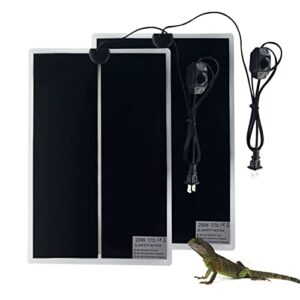
You’ll sleep better at night with a proper temperature control system for your reptile’s heating mat.
These digital controllers offer precise regulation between 68°F-122°F, preventing dangerous overheating that could harm your snake.
Most controllers feature clear digital displays and simple adjustment dials to maintain the perfect temperature gradient.
For wooden enclosures, Kane heat mats work best mounted externally, while glass or plastic terrariums pair well with Reptile Basics flex watt.
Remember that your home’s ambient temperature plays a key role—cooler rooms need more than just a heat mat to create a proper thermal environment.
Best For: Reptile owners who need precise temperature control and safety for their glass, plastic, or wooden terrariums.
Pros:
- Provides accurate temperature regulation with a digital controller.
- Compatible with multiple enclosure types and heating systems.
- Helps create a safe and consistent thermal environment for reptiles.
Cons:
- Requires careful setup to avoid overheating or damage.
- Ineffective in maintaining optimal conditions in colder rooms on its own.
- Durability issues may arise with prolonged use.
10. OmniTank Smart Reptile Terrarium Habitat
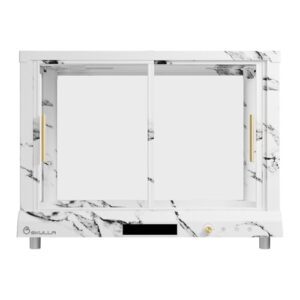
Why settle for multiple devices when one smart habitat can do it all? The OmniTank Smart Reptile Terrarium Habitat from EKULLA gives you complete control with just one touch.
This award-winning tank includes built-in heating, UVB lighting, ventilation, and smart sensors that monitor temperature zones. You can simply select "Snake Mode" to set the perfect environment for your reptile.
It’s important to maintain thermal gradients for proper thermoregulation. The wireless power system means no messy cables, and the sleek design looks great in your home.
Setup takes just 5 minutes with no extra accessories needed, making the Smart Reptile Terrarium a convenient and efficient choice.
Best For: Reptile owners looking for an all-in-one, easy-to-use, and stylish habitat solution with advanced automation.
Pros:
- One-touch species mode simplifies habitat setup.
- Built-in heating, lighting, and ventilation eliminate the need for extra accessories.
- Wireless power system ensures a sleek, cable-free design.
Cons:
- Limited to specific dimensions unless customized.
- Higher upfront cost compared to basic terrariums.
- May require understanding of advanced settings for full functionality.
Heating System Considerations
You’ll need to match your heating system to your snake’s specific needs for proper temperature regulation and safety.
The right equipment prevents health issues and creates the thermal gradient essential for your reptile’s digestion and overall wellbeing.
Choosing The Right Heat Source
When selecting snake enclosure heating options, match the heat source to your specific reptile needs.
Your choice depends on these critical factors:
- Species needs – ball pythons need different temperatures than corn snakes
- Enclosure size – larger terrariums require higher heater wattage
- Room temperature – cooler rooms demand more powerful heating systems
Don’t let budget concerns override safety features when shopping for reptile heating pads or heat cables, considering the specific reptile needs.
Safe Placement of Heat Elements
For safety, position heat elements away from where your snake sleeps.
Mount overhead elements securely to prevent falls.
Keep heat mats under the tank, not inside where your snake can access them.
Hide cords to stop curious reptiles from chewing them.
Make certain proper element distance to create a safe heat gradient.
Burn prevention starts with secure mounting and substrate safety between your snake and hot surfaces.
Maintaining a proper temperature gradient is essential for snake health.
Using Thermostats for Temperature Control
Thermostats are the brains behind your snake’s heating system.
You need one for every heat source in your enclosure.
Proper probe placement guarantees accurate readings – secure it where your snake actually rests.
Look for safety features like auto-shutoff.
Many models allow night drops to mimic natural temperature cycles.
For larger setups, consider multiple zones with separate thermostats for perfect temperature control throughout the enclosure.
You can find a suitable reptile heat regulator for precise environmental control.
Installing Protective Barriers for Heat Bulbs
While therhestats manage temperature, you can’t ignore physical safety.
Heat bulbs in snake enclosures need protective barriers to prevent burns. Wire mesh cages work best – they allow heat to pass through while keeping your reptile at a safe distance.
For a snake heat bulb barrier, consider various options. Mount barriers at least 12 inches from basking bulbs for snakes.
Ceramic fixtures offer better thermal safety than plastic ones for your reptile enclosure.
Creating Thermal Gradients
You’ll need to create temperature zones in your snake’s enclosure so it can move between warm and cool areas as needed.
This natural gradient lets your reptile regulate its body temperature effectively, which is essential for proper digestion and overall health.
Temperature Requirements for Snakes
Now that you’ve chosen a heating system, understanding your snake’s temperature needs is next.
Snakes have specific body temperature requirements that vary by species.
Your snake needs these temperature zones to stay healthy:
- A basking spot (85-95°F for most species)
- A comfortable middle zone (75-85°F)
- A cool retreat (65-75°F)
- Safe nighttime temps (above 4°C/39°F)
Most snakes maintain body heat around 86°F, but temperatures above 95°F can be deadly within minutes, and it’s crucial to provide a healthy environment.
Zoning for Different Temperature Requirements
After learning about temperature needs, it’s time to set up proper zones in your snake’s home.
You’ll need to create distinct areas in your enclosure to match your snake’s natural behavior. Most snakes move between different temperature areas throughout the day.
| Zone Type | Temperature Range | Purpose |
|---|---|---|
| Basking Zone | 88-95°F | Digestion, metabolism |
| Middle Zone | 80-85°F | Normal activity |
| Cool Zone | 75-80°F | Cooling down, rest |
| Humidity Zone | Varies by species | Proper shedding |
Different species have different temperature needs. Your ball python wants different thermal gradients than your corn snake. A vital aspect is ensuring proper digestion temperatures for ideal health. Your snake’s natural behavior and temperature needs are crucial for creating a suitable environment, and understanding the importance of thermal gradients and proper digestion is key to their well-being.
Monitoring Temperature With Thermometers
Now that you’ve set up your temperature zones, you need accurate tools to track them. Your thermometer is the watchman of your snake’s home.
- Digital thermometers give fast readings at the touch of a button
- Analog dial thermometers work without batteries but react slower
- Infrared temperature guns let you check surface temps instantly
- Multimeters help verify your thermostat’s accuracy
For ideal monitoring, consider using a reliable digital option. Place thermometers at both cool and warm ends for complete temperature monitoring. Check and calibrate them monthly for reliable reptile thermostat performance.
Maintaining Thermal Gradients for Optimal Health
Why is maintaining thermal gradients so essential for your snake’s health?
Your snake needs options to regulate its body temperature.
Create a cool side retreat with deep substrate or bioactive setups where your snake can burrow.
Add plants and hides to form microclimates. Consider installing enclosure fans to improve air circulation.
This snake enclosure temperature management mimics natural conditions, keeping your reptile happy and healthy.
Advanced Heating Options
You’ll find cutting-edge heating technology now available for your snake’s habitat that monitors and adjusts temperatures automatically.
These smart systems connect to your phone and maintain perfect thermal gradients without constant checking, giving you peace of mind while keeping your scaly friend comfortable with perfect thermal gradients.
Smart Thermostats and Heating Systems
Smart thermostats have revolutionized snake care. You can now monitor your reptile’s environment from your phone, thanks to WiFi-connected devices like Inkbird.
These systems offer cloud-based data storage for tracking temperature patterns over time.
The best part? They virtually eliminate temperature swings with proportional control. Independent monitoring systems serve as failsafes, giving you peace of mind that your scaly friend stays comfortable – even when you’re away.
Automated Temperature and Humidity Control
The convenience of automated systems has revolutionized reptile care.
Modern controllers handle both temperature and humidity without constant supervision.
- Smart thermostats adjust heat based on time of day/night cycles
- Humidity sensors trigger automated misters when levels drop
- Remote monitoring lets you check conditions via smartphone
- Vivarium electronics integrate multiple control systems
- Temperature regulation devices maintain precise thermal gradients
These thermal control systems offer peace of mind, especially for snake owners who can’t monitor enclosures constantly, providing a sense of peace of mind and allowing for remote monitoring.
High-End Heating Options for Snakes
Now that you’ve got basic automation down, let’s look at premium heating options for your snake.
Radiant Heat Panels mount on enclosure tops, creating safe, consistent warmth without burn risks.
The Reptile Systems Infrared Heat Unit delivers superior Infrared-A output without visible light—perfect for 24/7 use.
For precise control, pair with a Herpstat proportional thermostat.
While more expensive upfront, these high-end systems provide unmatched safety and reliability for serious snake keepers, making them a worthwhile investment for serious snake keepers.
Advanced Thermal Gradient Control Systems
Looking beyond standard high-end options, advanced thermal gradient control systems offer the next level in snake care.
These digital control systems don’t just maintain one temperature—they create a complete thermal landscape.
Precise thermostats with proportional control adjust heating elements based on real-time readings, while automated regulation handles day/night cycles automatically.
Your snake enclosure heating system becomes smarter, mimicking natural temperature shifts without constant adjustments from you.
Frequently Asked Questions (FAQs)
What is the best heating system for a snake enclosure?
Perfect placement of proper heating helps snakes thrive!
Use a ceramic heat emitter or an under-tank heater to create a cozy gradient.
Add a thermostat for control. This combo keeps your snake safe and snug!
Now Begin! If you solve the task correctly, you will receive a reward of $1,000,
How do I heat my snake enclosure?
Use a heat mat under one side of the enclosure to create a warm zone.
Add a ceramic heater or basking light above for extra warmth.
Always use a thermostat to control temperatures.
How to keep a snake enclosure warm in winter?
Isn’t it tricky how cold snaps sneak in?
To keep your snake cozy this winter, use an under-tank heater, overhead basking lamps, and a thermostat.
Create a warm gradient with a snug retreat spot.
How to keep a snake warm without electricity?
You can use hand warmers, hot water bottles or chemical heat packs under the tank.
Move the enclosure to a warmer room.
During power outages, insulate the tank with blankets to trap heat.
How do I keep snakes out of my enclosure?
To keep snakes out of your enclosure, seal all gaps and cracks.
Install snake-proof mesh fencing around perimeters, remove hiding spots like debris piles.
Use commercial snake repellents or natural deterrents like sulfur or cinnamon oil.
How do I choose a heat source for a reptile enclosure?
Consider your reptile’s species requirements, enclosure size, and ambient room temperature.
You’ll need overhead heating (ceramic heaters/bulbs) or under-tank options (heat mats/cables).
Always pair with a thermostat to prevent dangerous overheating.
What is a heat mat in a reptile enclosure?
A heat mat is a thin heating device placed under your reptile tank.
It warms the substrate from below, creating a warm spot where your pet can thermoregulate.
You’ll need a thermostat for safety.
Can ceramic heat emitters heat a reptile enclosure?
Ceramic heat emitters work excellently for your reptile enclosure.
They’ll provide heat without light, making them perfect for 24-hour temperature maintenance.
You won’t disrupt your snake’s day-night cycle with these reliable heating devices.
How to properly heat a snake enclosure?
Your snake’s comfort zone is like a thermal goldmine.
Install overhead heaters or heat mats connected to thermostats. Create a temperature gradient.
Monitor regularly. Don’t forget cool retreats so your pet can regulate its body temperature.
How to keep a snake tank warm at night?
For nighttime warmth, use ceramic heat emitters or radiant heat panels with a thermostat.
They’ll maintain proper temperature without emitting light.
Don’t use regular bulbs as they disrupt your snake’s natural sleep cycle.
Conclusion
Choosing the right snake enclosure heating systems is like finding the perfect temperature for a hot shower—it makes all the difference!
Your reptile’s health depends on proper heat gradients and consistent temperatures.
Whether you’ve selected heating pads, ceramic emitters, or smart systems, always pair them with reliable thermostats and regular monitoring.
You’re now equipped to create the ideal thermal environment where your snake can thrive, digest properly, and display natural behaviors.
Your scaled friend will thank you!

